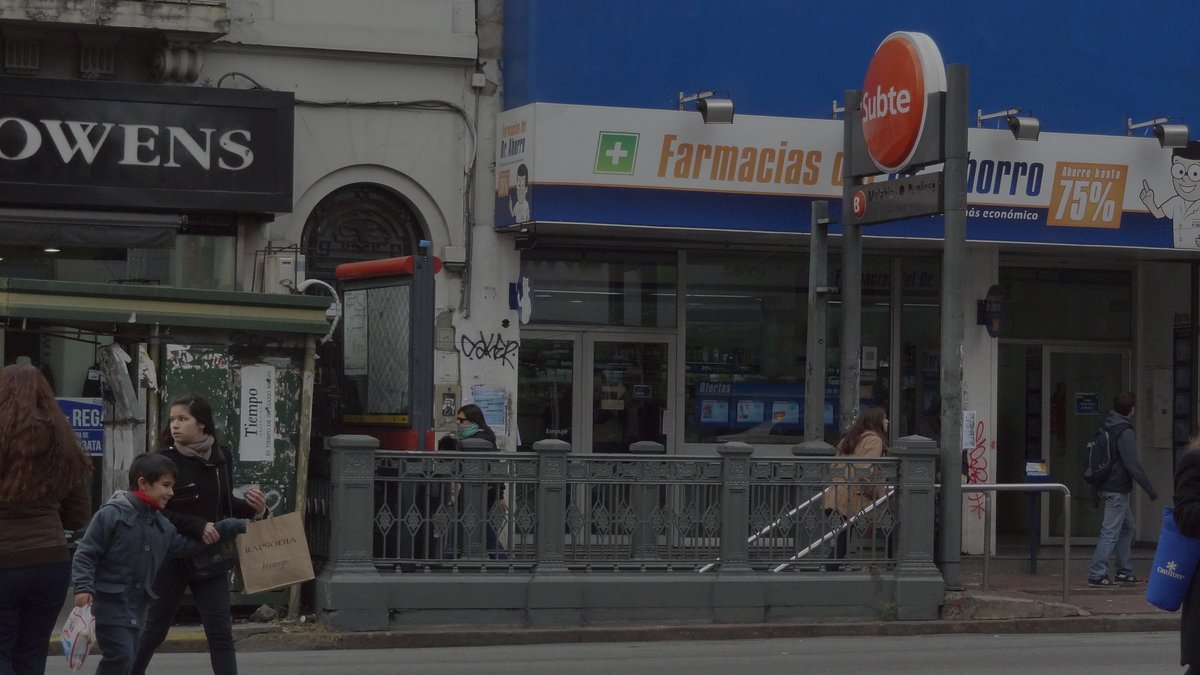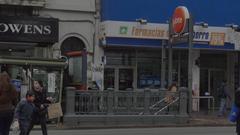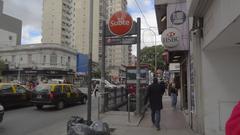
Malabia/Osvaldo Pugliese Station Visiting Guide: Buenos Aires Historical Sites
Date: 15/06/2025
Introduction
Malabia/Osvaldo Pugliese Station is a unique intersection of Buenos Aires’ vibrant history, cultural heritage, and modern urban life. Located in the heart of Villa Crespo, one of the city’s most dynamic neighborhoods, this Line B subway station is more than just a transit point—it’s a living monument to the legendary tango composer Osvaldo Pugliese and a gateway to some of Buenos Aires’ most beloved attractions. This comprehensive guide provides everything you need to know for a rewarding visit, from practical details like visiting hours and ticketing to the station’s cultural significance, architectural features, and nearby sites.
Table of Contents
- Origins and Construction
- Cultural Dedication and Artistic Significance
- Architectural Features and Evolution
- Visiting Hours, Tickets, and Accessibility
- Station Layout and Facilities
- Travel Tips for Visitors
- Nearby Attractions and Guided Tours
- Role in Urban Landscape and Community
- Modernization and Preservation
- Frequently Asked Questions (FAQ)
- Visuals and Media Recommendations
- Summary and Key Takeaways
- Sources and Further Reading
Origins and Construction
Malabia/Osvaldo Pugliese Station was inaugurated in 1930 as part of the original segment of Line B, marking a pivotal point in Buenos Aires’ urban development. It was one of the first subway lines in the city to utilize technological advancements such as third-rail electrification and steel-bodied trains, accelerating the connection between Villa Crespo and the city center (YoMetro). The station was originally named “Malabia” after the street above, itself named in honor of Pedro Malabia, an important Argentine lawyer and politician.
Cultural Dedication and Artistic Significance
In 2010, the station was renamed to Malabia/Osvaldo Pugliese to commemorate the legacy of Osvaldo Pugliese, a native of Villa Crespo and one of Argentina’s most influential tango composers and pianists. The station now features murals and exhibits that celebrate Pugliese’s musical achievements and his role in the city’s working-class history. These public artworks, such as Luz Zorraquín’s “Metamorfosis: de flor a tomillo” mural, reflect Buenos Aires’ tradition of integrating art into public spaces (Wikipedia, Urbano Cotidiano).
The nearby monument to Pugliese at the intersection of Scalabrini Ortiz, Corrientes, and Luis María Drago is a further testament to his enduring influence (Ser Argentino).
Architectural Features and Evolution
The station’s original design includes early 20th-century ceramic tilework, sturdy columns, and a functional layout. Over the decades, modernization projects have introduced improved lighting, signage, and accessibility features, including escalators, elevators, and tactile paving for visually impaired passengers. The station is about 16 meters underground and features two side platforms, each capable of accommodating six-car trains. Bilingual signage (Spanish and English) assists international visitors (Subte Buenos Aires).
Visiting Hours, Tickets, and Accessibility
- Operating Hours: Daily from approximately 5:00 AM to 11:00 PM on weekdays, with slightly shorter hours on weekends and holidays (Subte Buenos Aires).
- Tickets: Access is via the rechargeable SUBE card, available at station kiosks, ticket offices, and convenience stores. Fares (as of June 2025) are ARS 125 per ride, with discounted rates for frequent use. The SUBE card itself costs ARS 670 (SUBE Official).
- Accessibility: The station is equipped with elevators, tactile paving, and audio announcements, ensuring access for travelers with reduced mobility or visual impairments. However, elevator access may occasionally be limited; check ahead if you have specific needs.
Station Layout and Facilities
Platforms and Entrances
- Configuration: Two side platforms accessed via stairs and escalators.
- Entrances: Multiple, located along Avenida Corrientes and adjacent streets.
- Concourse: Houses automated SUBE card machines, staffed ticket windows, and clear bilingual signage.
Amenities
- Restrooms: Public restrooms are available within the station.
- Wi-Fi: Complimentary Wi-Fi access throughout the facility.
- Security: CCTV surveillance, emergency intercoms, and on-site staff.
- Shops and Services: Newsstands and kiosks offer snacks, drinks, and newspapers. Avenida Corrientes’s cafés and bakeries are close by.
- Bicycle Facilities: Public bike racks are located nearby, and the Ecobici public bike-sharing system operates in the area.
Travel Tips for Visitors
- Best Time to Visit: Mid-mornings, early afternoons, and weekends are less crowded. Avoid rush hours (7:00–10:00 AM and 5:00–8:00 PM).
- Safety: The station is generally safe, but as with any urban area, keep valuables secure and be aware of your surroundings.
- Local Customs: Stand in line at ticket machines and platform entrances. Offer priority seating to those in need. Eating and drinking are not permitted on trains.
- Language: Spanish is predominant; some staff speak English. Translation apps can be helpful.
- Weather: June temperatures range from 8–16°C (46–61°F). Dress accordingly.
Nearby Attractions and Guided Tours
Malabia/Osvaldo Pugliese Station is a convenient base for exploring Villa Crespo and nearby neighborhoods:
- Avenida Corrientes: Renowned for theaters, bookstores, and nightlife (Buenos Aires Ciudad).
- Mercado de Villa Crespo: Popular for local foods and crafts.
- Parque Centenario: A large urban park about 1 km away (Buenos Aires Ciudad).
- Tango Venues: Experience live tango performances at local milongas.
- Imperio Pizzería: An iconic local eatery since 1946.
- Bernardino Rivadavia Natural Sciences Museum: A short walk from the station.
- Palermo Soho: Accessible via subway for shopping and dining (Mapcarta).
Guided tours of Villa Crespo often include the station and its surroundings, and the station’s murals and nearby Pugliese monument are excellent for photography.
Role in Urban Landscape and Community
Malabia/Osvaldo Pugliese Station is vital in linking Villa Crespo—a historically immigrant, working-class neighborhood—with the wider city. The station serves as a social and cultural hub, supporting local institutions like Biblioteca Popular Alberdi and providing access to educational and gastronomic landmarks. Community events, particularly around Pugliese’s birthday and other commemorative dates, reinforce its status as a living monument to tango, memory, and solidarity (Ser Argentino).
Modernization and Preservation
Ongoing modernization has improved lighting, signage, and security, while restoration projects ensure the preservation of architectural and artistic features. Integration with the unified SUBE card system facilitates seamless travel across Buenos Aires’ transport network, supporting sustainable urban mobility (Buenos Aires Ciudad). Future plans aim to further upgrade accessibility and amenities.
Frequently Asked Questions (FAQ)
Q: What are the visiting hours of Malabia/Osvaldo Pugliese Station?
A: The station is open from approximately 5:00 AM to 11:00 PM on weekdays; hours may be reduced on weekends and holidays.
Q: How do I purchase tickets?
A: Use a SUBE card, available at station kiosks, ticket offices, or convenience stores. Cards can be recharged at the same places or online.
Q: Is the station accessible for people with disabilities?
A: Yes, with elevators, tactile paving, and audio announcements, though elevator access may be occasionally limited.
Q: Are there restrooms at the station?
A: Yes, public restrooms are available inside the station.
Q: What attractions are nearby?
A: Avenida Corrientes, Mercado de Villa Crespo, Parque Centenario, tango venues, and the Osvaldo Pugliese monument.
Q: Are there guided tours?
A: While there are no tours dedicated solely to the station, many city tours include stops in Villa Crespo.
Q: How safe is the station?
A: The station is generally safe, with security personnel and CCTV, but standard precautions are recommended.
Visuals and Media Recommendations
- Include high-quality images of station murals, architectural details, and the nearby Pugliese monument.
- Use alt text with keywords such as “Malabia/Osvaldo Pugliese station visiting hours” and “Buenos Aires historical sites.”
- Interactive maps and virtual tours are available via the official Buenos Aires tourism site.
Summary and Key Takeaways
Malabia/Osvaldo Pugliese Station is a testament to Buenos Aires’ commitment to blending heritage with modern urban life. From its pioneering role in the city’s subway system to its current status as a cultural landmark honoring Osvaldo Pugliese, the station provides both practical transit solutions and a rich tapestry of history and art. With easy access, robust amenities, and proximity to some of the city’s best cultural sites, it is an essential destination for travelers seeking an authentic Buenos Aires experience.
For up-to-date information, visit the official Subte Buenos Aires website and consider downloading the Audiala app for real-time updates and travel planning.
Sources and Further Reading
- Malabia/Osvaldo Pugliese (Buenos Aires Underground) – Wikipedia
- Visiting Hours, Tickets, and Exploring Buenos Aires’ Historical Site – YoMetro
- Malabia/Osvaldo Pugliese Station – Buenos Aires Ciudad
- Station Information – Subte Buenos Aires
- Monument to Osvaldo Pugliese – Ser Argentino
- Estación Malabia Osvaldo Pugliese – Urbano Cotidiano
- SUBE Official
- Mapcarta – Palermo Soho
- Journey by Backpack – Buenos Aires Guide
- Buenos Aires Shopping – Outlet Shopping Villa Crespo































































































































































